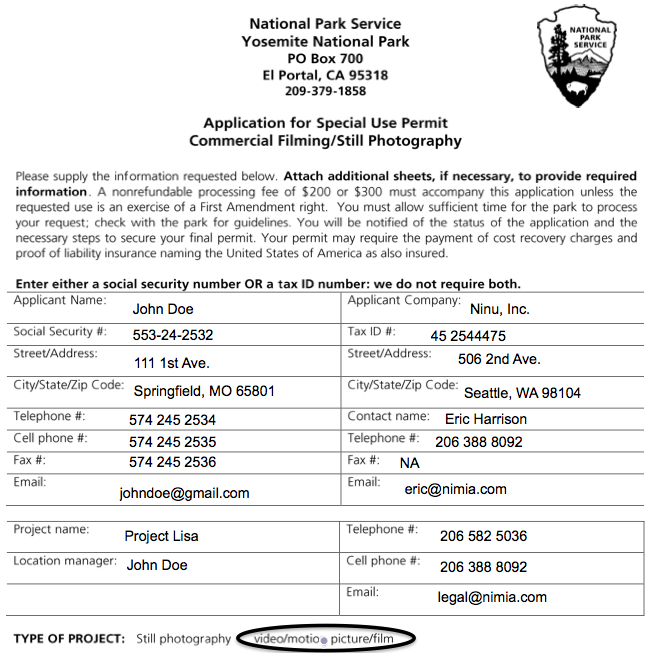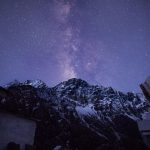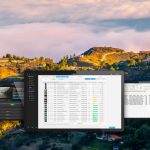Our National Parks can offer filmmaker a lifetime’s worth of beautiful footage — from mountain peaks, to waterfalls, to ocean waves and desert-scapes. But, shooting in a national park isn’t as simple as showing up with a camera. If you plan to shoot in a national park, you need to: (i) obtain a permit; (ii) pay a fee; and (iii) have a $1 million insurance policy naming The United States of America as “additional insured” on the insurance certificate.
Sound a little overwhelming? We thought so too. Nimia’s legal team is aware that the insurance policy required for commercial filming in National Parks may be an obstacle for independent producers. We are here to help and support you, so if you have a Nimia member account and use our platform to promote your videos, Nimia offers you coverage through its insurance policy at no extra cost for you.
How it works:
If you plan to shoot on federal public land, contact us at [email protected] in advance to get more information on how to use our insurance policy coverage.
When you are ready to film in a National Park, fill out the permit application using Nimia as the “Applicant Company” and you as the person filming “Applicant Name”, and Nimia will handle the $1 million insurance coverage requirement. Click here to see an example application.
The Legalities of Filming in National Parks
Filming in national parks is regulated by Public Law 106-206, codified at 16 USC 460l-6d, and Part 5 of Title 43 of the Code of Federal Regulations.
The law distinguishes between ‘commercial filming’ and ‘still photography’ when it comes to permit requirement.
Commercial filming
The law requires you to obtain a permit and pay a fee if you film on federal public land with the intent of generating income from the footage:
“Commercial filming means the film, electronic, magnetic, digital, or other recording of a moving image by a person, business, or other entity for a market audience with the intent of generating income. Examples include, but are not limited to, feature film, videography, television broadcast, or documentary, or other similar projects. Commercial filming activities may include the advertisement of a product or service, or the use of actors, models, sets, or props.”
If you don’t plan to make a profit from the footage shot on public federal land and the footage is intended for personal use only, you are not required to obtain a permit and pay a fee.
Still photography
Still photography on public federal land, as opposed to ‘commercial filming’, is not a priori subject to obtaining a permit. Permits are only required for still photography if:
1) You are going to use a model, set or prop; or
2) The agency determines the permit is necessary because you are going to shoot in a place not generally accessible to the public or the agency would incur costs for on-site management, oversight to protect resources or minimize visitor use conflicts.
Getting Your Permit
The law requires you to get a permit if you film with the intent to make money out of your footage or if you take pictures using models, sets or props, or shoot in a place inaccessible to the general public, or the shooting is likely to have the agency incur into costs.
Permits may be denied if the respective agency finds there is a likelihood that the proposed activity may:
- Cause resource/environmental degradation;
- Unreasonably disrupt or conflict with the public’s use and enjoyment of the site;
- Pose health or safety risks to the public;
The permit requirement is premised on the assumption that ‘commercial filming’ (motion pictures and TV productions) usually involves the use of a number of vehicles, models, sets, people, etc. which involve a risk of damage and disruption per se. So if you plan to shoot in a national park remember to get yourself acquainted with the requirements set by the given park management. We have gathered for your convenience all the information on permits, fees and contacts for the top 10 national parks:
1) Great Smoky Mountain National Park (NC, TN)
2) Grand Canyon National Park (AZ)
3) Yosemite National Park (CA)
4) Yellowstone National Park (WY,MT, ID)
5) Olympic National Park (WA)
6) Rocky Mountain National Park (CO)
7) Zion National Park (UT)
8) Grand Teton National Park (WY)
9) Acadia National Park (ME)
10) Glacier National Park (MT)
If you plan to shoot in federal public land that is not a national park, you should take a look at the policy on film permits here and information on filming fees, here.
2) National Conservation Areas
6) National Scenic and Historic Trails
By accessing and reading this blog, you acknowledge and understand that no attorney-client relationship has been formed and you further acknowledge and understand that this blog is not intended to constitute legal advice. Legal advice and counsel requires a fact-specific analysis of your particular issues, and you should thus obtain legal advice directly and individually from an attorney licensed to practice in your jurisdiction, if appropriate.



